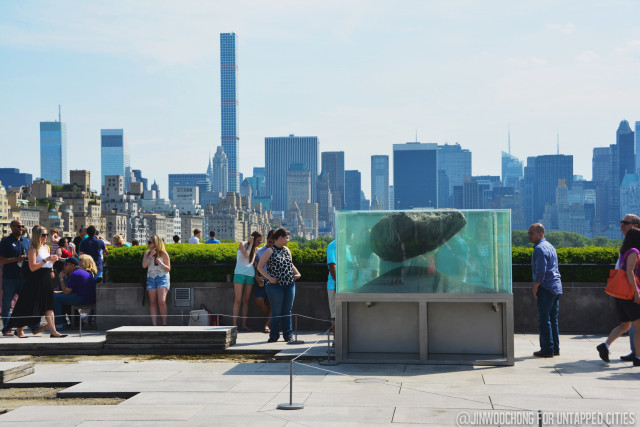
As you may know from our Top Ten Secrets of the Metropolitan Museum, The Met’s got a roof bar with a view, and this past month, its annual summer exhibit went up, this time a modern sculpture garden complete with a deconstructed floor. French artist Pierre Huyghe (pronounced hweeg) arrived at the Metropolitan Museum of Art on May 12 with a sculptural installation designed especially for the museum’s Iris and B. Gerald Cantor Roof Garden.
For nearly two decades, Huyghe has blazed quite an unconventional trail through the scape of contemporary art. With a cross-medium body of work that includes film, sculpture, landscaping, even the use of live fish and other natural elements, Huyghe has an aesthetic that is difficult to categorize. Take for example the 2011 installation “The Host and the Cloud,” which ran at New York’s Marian Goodman Gallery on West 57th Street and consisted of an original film premiere accompanied by three color-coordinated tanks filled with fish, anemone, and other assorted exotic sea life. Said the nonplussed New York Times art critic Roberta Smith, “the fish in their tanks come much closer to viable art.”

According to the official program, the project at the Met is meant to explore “the transformation of cultural and biological systems through a dynamic gathering of components derived from the Museum’s collection, architecture, and surroundings.”
Set against the sprawling scape of Central Park and the Upper West Side, the aptly named Roof Garden Commission’s most striking centerpiece, among an industrial zen-garden made of overturned stone slabs and patches of exposed dirt in the floors, is a water tank that seems to defy gravity, suspending a boulder-sized rock over a pile of fine sand. The tank’s walls flash in and out of transparency and frosted opacity, often startling viewers leaning in for a closer look.
The project has no set floor plan; guests are made to walk in and around the area as they please, often stopping to enjoy the view and the patio along with the museum’s rooftop bar almost as much as they look at the installation.

However, this unconventional duality is perhaps to be expected of an artist who routinely defies where the art ends and the frame begins. Blending form, content, and exhibition seems the real centerpiece of the Roof Garden Commission.
Sheena Wagstaff, the Museum’s Leonard A. Lauder Chairman of Modern and Contemporary Art, said in the Met’s official press release: “Pierre has approached the Museum as if it were a mine by excavating the site and incorporating objects that are sourced within the Museum’s collection, its architectural layers, and the geological history of Central Park. The resulting matrix of mutating organisms rewards close attention as they shift and manifest themselves over the course of the summer, providing a unique experience each time the Roof Garden is visited.”

Still, from an artist whose previous projects have included working with a University of Rochester scientist to engineer the fictional butterflies (checkerboard patterned wings and all) that Vladimir Nabokov often sketched for his wife, Vera, or heading to the evacuated site of the Fukushima nuclear disaster to film a Youtube-famous (or perhaps infamous) restaurant and its part-time waiter, a Macaque monkey in a dress and a human mask, the project seems relatively tame.
Nevertheless, Huyghe, who has claimed a steady showing of projects that circle the globe and span the entirety of fine arts’ various media, is still going strong. Perched on the roof of the single largest art museum in the country, the Roof Garden Commission is only the latest in the artist’s 25-year career. No word yet on if the garden’s water tank contains any tropical fish.
Next, read about The Top 10 Secrets of the Metropolitan Museum of Art. Get in the touch with the author at @jinwoochong.






